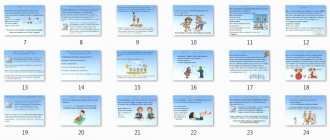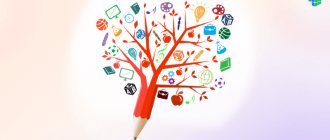Integrated learning technology
The concept of integrated learning includes not only a tolerant attitude, but also the use of modern technologies in education. After all, the transition to this type of progressive education requires modernizing the entire school system. Namely:
- attract the necessary specialists who will assist teachers during teaching;
- use innovative pedagogical solutions and ideas;
- adapt the curriculum to take into account the characteristics of all children in an integrated class;
- place emphasis on the development of creative and cognitive abilities;
- actively involve parents in the educational process.
When working with special children, the teacher needs the help of a specialized specialist
Principles of integrated learning
Integrated learning has its own principles and features:
- develops the individual characteristics of each child;
- creates conditions for close interaction between the school, teachers, specialists and parents;
- teaches a specific culture that helps children respect children who are different from them and accept differences without offending others;
- creates a supportive space where every child feels valued and able to cope with all tasks.
Goals and objectives of integrated learning
An integrated approach to teaching is a methodology that allows you to successfully solve goals and objectives related to the socialization and transfer of knowledge to children with inclusion of varying degrees of severity.
Purpose of Integrated Learning
The goal of integrated education is to help a child with developmental disabilities learn to communicate successfully with other children and gain training and skills to be realized in life.
Training in Japan using integrated educational programs has existed since 1990, and norms and acts of inclusive education began to be developed since the 70s.
Objectives of integrated learning
Integrated training solves the following problems:
- create special conditions for children with special needs;
- help such children master the curriculum without deviating from school education standards;
- reduce or reduce functional impairment in children;
- create a respectful and accepting atmosphere;
- establish dialogue with other children, teach communication;
- support in matters of training and socialization;
- provide psychological support;
- develop a positive attitude towards yourself and life.
Lev Semenovich Vygotsky was the first to talk about the importance of developing the concept of integrated teaching methods. He believed that correctional schools, which were created specifically for children with disabilities, did not provide the necessary skills needed for adult life. On the contrary, they aggravate the condition of children by focusing attention on problems.
Integrated Learning Models
In addition to the forms, there are such modern models of organizing integrated inclusive education as:
- continuous full integration;
- constant but incomplete integration;
- partial integration;
- time integration;
- episodic integration;
- combined integration.
Continuous full integration
With this model of integrated education, children with inclusion attend a general education school together with other students and receive additional correctional assistance if necessary. Permanent full integration is possible in two cases:
- the child’s level of development is close to normal, without significant deviations;
- In addition to the teacher, the school also has a separate specialist.
Constant but incomplete integration
This model is suitable for children who have deviations from the age norm. They require specialized assistance and cannot attend all classes at the same time as other students. Teachers and parents determine which subjects the child will take with the class, and what is easier to master with the help of a specialist.
Partial integration
In this model, greater importance is given to the individual education of a child with special needs. And he attends classes at a comprehensive school only partially or spends time with children after his main studies.
The earlier developmental features are identified, the greater the chances for successful adaptation.
Temporal integration
In this model of integrated learning, an inclusion child spends time with regular children at school at least twice a month. And he studies individually according to a specially developed program.
Episodic integration
This model is used in schools where it is not possible to organize full-fledged integrated training: there is no separate specialist, there is no opportunity to modernize teaching. In this case, periodic events are organized that help socialize children with special needs.
Combined Integration
A learning model that is used in small localities if they do not have opportunities for any kind of integrated education. In this case, only some elements of inclusive education are used. Therefore, the combined model is suitable for children with minimal developmental disabilities, otherwise they simply will not be able to master the educational program on an equal basis with other students.
Forms of integrated learning
According to the organization of the educational process, four forms of integrated learning are distinguished:
- attending a regular secondary school class;
- attending a special class in a secondary school;
- studying in a correctional school with subsequent transfer to a general education school;
- full or partial inclusion in the educational process during vocational training.
By the way! Our readers now have a 10% discount on any type of work.
Pros and cons of integrated learning
Let's take stock and look at the advantages and disadvantages of integrated learning.
Advantages of integrated learning
- development of individual abilities of each child;
- helping children with special needs integrate successfully into society;
- the ability not to get stuck in problems;
- developing empathy and the ability to help other people;
- formation of a tolerant culture.
Integrated education is a chance for special children to find their place in society
Disadvantages of Integrated Learning
- a child with special needs often requires too much attention and time, which the teacher cannot always give;
- lack of attention to ordinary children can affect their academic performance;
- risk of bullying from other students;
- it is difficult to train the necessary specialists;
- It is necessary to rebuild the entire education system.
Our world is becoming more inclusive every year: ramps are appearing in public places, new approaches to socialization, including education. Therefore, if you are already studying or planning to enroll in faculties of pedagogy, psychology or social work, take a closer look at this topic. The demand for competent specialists will grow, which means this is an excellent direction for professional development.
Look at examples of work and make sure that we will help you conscientiously!
And if you need help writing coursework or dissertations, feel free to contact the student service. Our experts will take into account all the design requirements and write the work on time.







